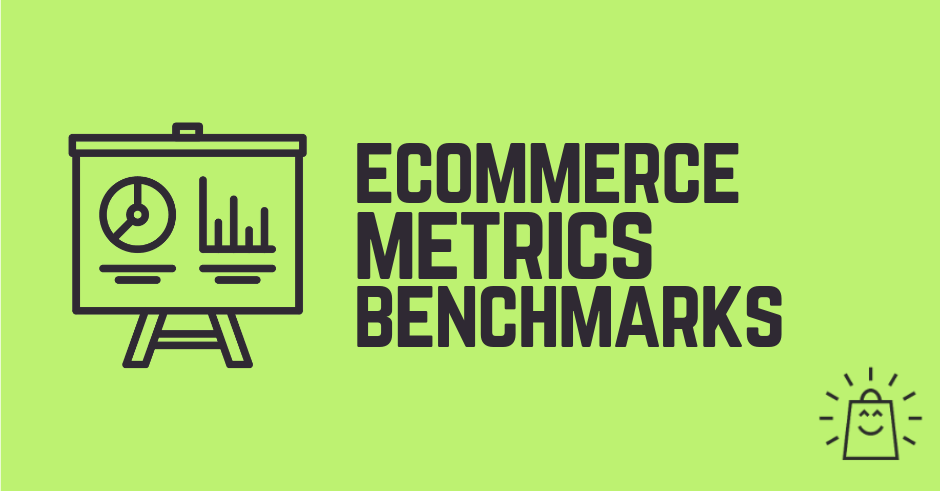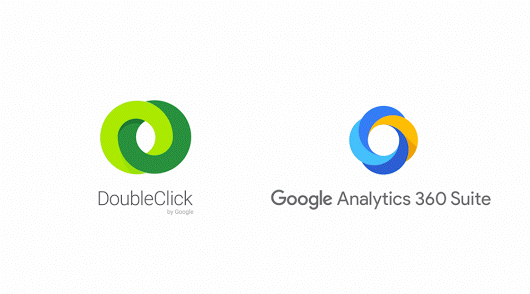Last Updated on April 30, 2021

I use a lot of ecommerce benchmarks in my client projects. For new clients, these metrics offer a great way to put together a plan to set goals and expectations. And with existing clients, benchmarks are good way to see how we stack up against others.
This article bundles all of the different research and reports that I have collected over the years.
Data disclaimer: I try to focus on recent, high quality studies with a large enough sample sizes. But benchmarks can vary between studies for a number of reasons.
So keep that in mind while you go through the list below. These ecommerce metric benchmarks are meant to give you direction, not a hard target.
This list of metric benchmarks is a long one. Use the links below to skip to the section you need.
Table of Contents
Traffic sources
Traffic sources (by visitors)
| Channel | Share of traffic |
| Organic | 32% |
| Paid search | 33% |
| Direct | 12% |
| 9% | |
| Social | 8% |
| Display | 2% |
| Referral | 1% |
| Other | 2% |
Source: Wolfgang KPI Report (2020)
Notes: study with over 130 million website sessions and over €330 million in online revenue between November 2018 – October 2019
Why should you care?
Compare this with your own traffic sources to see which traffic where you might be underperforming.
Traffic sources (by revenue)
| Channel | Share of revenue |
| Organic | 31% |
| Paid search | 36% |
| Direct | 13% |
| 7% | |
| Social | 4% |
| Display | 2% |
| Referral | 3% |
| Other | 4% |
Source: Wolfgang KPI Report (2020)
Why should you care?
How do your traffic sources stack up? Does your list look different than the ones sorted by visitors? This can be an indicator that the effectiveness of your investments is off. You could be attracting a lot of organic traffic, but get no sales from it. This means that you’re missing critical links in addressing the buyer process.
Many of my own clients outperform the list above when it comes to paid search. Both in terms of traffic and revenue. This might show there are opportunities to invest in other channels.
Devices type
Device type (by visitors)
| Device | 2020 | 2019 |
| Mobile | 71% | 53% |
| Desktop | 21% | 37% |
| Tablet | 8% | 10% |
Source: Wolfgang KPI Report (2020)
Why should you care?
If you’re seeing different numbers, is this because of your industry or location? Or is it because your website performs poorly on mobile?
Device type (by revenue)
| Device | 2020 | 2019 |
| Mobile | 57% | 26% |
| Desktop | 33% | 56% |
| Tablet | 8% | 10% |
Source: Wolfgang KPI Report (2020)
Why should you care?
Segment your own revenue by device type to see what your breakdown looks like. The most common observation: attracting mobile visitors that convert poorly.
On-site engagement metrics
Average on site engagement metrics
| Metric | Value |
| Average pages per session | 5 pages |
| Average session duration | 2m 57s |
| Average bounce rate | 41% |
| Average page load time | 5.3s |
| Average server response time | 0.9s |
Source: Wolfgang KPI Report (2020)
Why should you care?
These numbers will vary widely depending on your industry and website. But a general rule is that more engagement with your site is better. If your numbers are totally off (such as a bounce rate of 88%), try comparing buyers to non-buyers on your site.
Bounce Rate (by traffic source)
| Traffic source | Bounce rate |
| Direct | 69.43% |
| 29.69% | |
| Search | 28.86% |
| Social | 42.52% |
| Unknown | 44.75% |
Source: Kibo Ecommerce Quarterly (2020)
Transaction path length
For the visitors that have converted, how many sessions did it take before they converted?
| Number of sessions | Share of sales |
| 1 session | 40% |
| 2 sessions | 60% |
| 3 sessions | 70% |
| 5 sessions | 81% |
| 12+ sessions | 100% |
Source: Wolfgang KPI Report (2017)
Why should you care?
Many store owners expect to make a sale the first time someone visits their site. These benchmarks show that most of your revenue will actually come from visitors that come back to your site. That’s why it is so important to have a strategy that brings visitors back to your website.
Ecommerce Average Order Value
Average order value (by traffic source)
| Traffic source | Average order value |
| Direct | $110.28 |
| $112.39 | |
| Search | $100.25 |
| Social | $82.38 |
| Unknown | $115.27 |
Source: Kibo Ecommerce Quarterly (2020)
Why should you care?
Your average order value (AOV) depends on the type of products you sell. But solid businesses bring in solid revenue. And building an ecommerce empire on $150 orders is a lot easier than doing it on $10 orders. If your order value is too, low, you might need new products or cross/upsell more effectively.
Average order value (by device)
| Channel | Bounce rate |
| Desktop | $126.57 |
| Mobile | $93.31 |
| Tablet | $107.82 |
Source: Kibo Ecommerce Quarterly (2020)
Average Order Value (by store performance)
| Percentile | Average order value |
| Top 25% | $102.93 |
| 25-50% | $97.73 |
| 50-75% | $88.31 |
| Bottom 25% | $74.73 |
Source: RJMetrics Ecommerce Growth Benchmark (2015)
Why should you care?
Although this study is from 2015, I keep it in because these numbers illustrate what separates great stores from average ones. If all else stays equal, the better performing stores get a 30% higher average order value. This extra revenue allows them to invest more and get even further ahead.
Ecommerce Conversion rate
Conversion rate (by channel)
| Top 25% | Average | |
| Referral | 13.47% | 5.44% |
| 10.16% | 5.32% | |
| Organic | 4.07% | 2.08% |
| Direct | 3.93% | 2.16% |
| Google Ads | 3.05% | 1.42% |
| 2.08% | 0.93% | |
| Social | 1.66% | 0.74% |
Source: Compass Ecommerce Conversion Rate Benchmarks (2018)
Note: data collected from over 10,000 online stores – top 25% = 25% of store with highest conversion rate
Why should you care?
The table shows a breakdown of the different conversion rates you can expect for each of your marketing channels. If you’re not hitting the average ones, maybe it’s time to review the effectiveness of your efforts.
Also compare the average with the conversion rates that the top 25% of the stores in the study are generating. For most channels, they convert more than DOUBLE the rate of the other stores. This gives them a huge competitive advantage.
[embedded content]
Conversion Rate (by device type)
| Device | Conversion rate |
| Desktop | 2.57% |
| Mobile | 1.80% |
| Tablet | 0.91% |
Source: Kibo Ecommerce Quarterly (2020)
Why should you care?
Mobile visitors convert at almost half the rate of desktop visitors. That’s a fact and these benchmarks illustrate it. So what do you do about it? Eliminate paying for mobile traffic? Probably not as that will limit your turnover. But continue to optimize your mobile experience is a good start.
Conversion Rate (by business model)
| Business model | Conversion rate |
| Dropshipping | 2.33% |
| Hybrid | 2.69% |
| Manufacturing | 3.25% |
| Private label | 3.98% |
| Reselling | 2.45% |
| Average | 3.02% |
Source: eCommerceFuel Ecommerce Trends report (2020)
Add-to-Cart Rates (by device type)
| Device | Conversion rate |
| Desktop | 10.93% |
| Mobile | 9.78% |
| Tablet | 12.20% |
Source: Monetate Ecommerce Quarterly (Q2 2018)
Why should you care?
If your visitors don’t buy, have a look at the add-to-cart rates for your store. Are people adding product to their baskets? You might need to configure extra ecommerce analytics to be bale to track this metric.
Cart Abandonment Rate
The average shopping cart abandonment rate is 69.80%.
Source: Baymard Institute (2020)
Notes: meta study from over 44 other studies
Why should you care?
It can be frustrating to see visitors add things to their carts, but then abandon the checkout later.
But most of these visitors were never going to buy anyway. About 58% of all those abandoned carts claim it’s because they were “just browsing”. Many use the shopping cart as a save for later list.
That doesn’t mean that there is nothing you can do about the remaining 40%. If you score below this benchmark, take a look how you could improve your checkout experience to generate more sales.
Annual Ecommerce growth rate
Stores with an annual revenue between $0-1 million have an annual growth rate of 137%.
Why should you care?
Keeping track of this metric is a pretty advanced thing to do. But if you know how fast the best stores in your industry are growing, it will help you to set realistic growth targets for your own store.
It’s a good indicator of when you will need to move past the low-hanging fruit and start exploring new sources of growth. In the early days of your company, you can double your business simply by building awareness. But after you’ll need to grow more deliberately: improve your website, start advertising or get serious about your email list.
Source: RJMetrics Ecommerce Growth Benchmark (2015)
Customer retention (by vertical)
| Vertical | Repeat purchase rate | Repeat customer revenue | Time between orders | Orders / customer | LTV | AOV |
| Apparel | 26.0% | 59.1% | 115 | 1.8 | $218 | $120 |
| CBD | 36.2% | 69.5% | 48 | 1.9 | $477 | $253 |
| Coffee | 29.6% | 64.1% | 148 | 2.3 | $169 | $74 |
| Cosmetics | 25.9% | 63.0% | 126 | 1.7 | $190 | $111 |
| Sport apparel | 33.0% | 64.0% | 71 | 2.0 | $161 | $81 |
| Meal deliveries | 29.0% | 51.0% | 41 | 1.6 | $63 | $40 |
| Food products | 24.5% | 47.3% | 94 | 1.6 | $118 | $72 |
| Pet products | 31.5% | 67.9% | 127 | 2.1 | $107 | $51 |
| Supplements | 29.1% | 58.1% | 75 | 1.7 | $94 | $56 |
| Tea | 20.9% | 48.4% | 132 | 1.5 | $55 | $36 |
| Average | 28.2% | 59.6% | 102 | 1.8 | $168 | $94 |
Source: Metrilo Customer Retention Report (2019)
Why should you care?
Getting repeat purchases is essential for any ecommerce business. But if you’re running a subscription company, the metrics above are your lifeline. A small improvement in any of these metrics can be the difference between running a thriving business, and going out of business.
Repeat Purchase Rate (by store performance)
Top 25% companies
- Month 2: 20% of revenue comes from repeat customers.
- Month 36 (3 years): revenue from repeat customers starts taking over revenue from new customers.
Bottom 75% companies
- Month 2: 10% of revenue comes from repeat customers.
- Month 36: revenue from repeat customers equals revenue from new customers.
Source: RJMetrics Ecommerce Growth Benchmark (2015)
Why should you care?
Solid businesses are build on repeat orders. It’s cheaper to get your existing customers to buy again, and if that revenue reaches scale, your store really grows leaps and bounds.
The top companies excel at retaining customers, even at the start of their business.
Ecommerce Margins
Average Gross Margin (by business model)
| Business model | Gross margin |
| Dropshipping | 32% |
| Hybrid | 45% |
| Manufacturing | 53% |
| Private label | 45% |
| Reselling | 36% |
| Average | 45% |
Source: eCommerceFuel Ecommerce Trends report (2020)
Why should you care?
The average gross margin for your industry might be very different. But one interesting remark from this study is that the gross margin increases with the size of the business increases. This makes sense because as the business grows in size, it should run its operations more efficient.
As said before, this metric can be a target. If you’re far below, you should explore how your competitors might be able to achieve better margins.
Average Net Margin (by business model)
| Business model | Net margin |
| Dropshipping | 15% |
| Hybrid | 18% |
| Manufacturing | 21% |
| Private label | 20% |
| Reselling | 13% |
| Average | 18% |
Source: eCommerceFuel Ecommerce Trends report (2020)
Google Ads benchmarks
These Google Ads benchmarks can help you spot areas where your campaigns are underperforming.
Google Ads Clickthrough Rate (by network)
- Search Network: 2.69%
- DisplayNetwork: 0.52%
Source: Wordstream Google Ads Benchmarks (2018)
Notes: data from 14,197 US-based WordStream client accounts in all verticals (representing over $200 million in aggregate Google Ads spend) who were advertising on Google’s Search and Display networks between August 2017 and January 2018
Why should you care?
I use this CTRs as a minimum threshold for my Google Ads campaigns.
Average Google Ads Clickthrough Rate (by percentile)
- 25th percentile: 1.91%
- 50th percentile: 3.23%
- 75th percentile: 5.58%
- 90th percentile: +9.5%
Source: Wordstream Google Ads data (2016)
Why should you care?
Rather than aiming for the average, these numbers show what great advertisers are doing. The best ones (in the 90th percentile) are getting almost 5X the CTR vs the lower performing ones. On Google Ads this translates into a great quality score, and a lower cost per click.
So beat your competitors by focusing on a great campaign structure!
Average Google Ads Cost Per Click (by network)
- Search Network: $1.16
- Display Network: $0.45
Source: Wordstream Google Ads Benchmarks (2018)
Why should you care?
The actual cost per click might be different for your industry. But these averages provide an easy way to make predications and rough estimates.
Average Google Ads Conversion Rates for Ecommerce
- Search: 2.81%
- Display: 0.59%
Source: Wordstream Google Ads Benchmarks (2018)
Why should you care?
Unlike other traffic sources, Google Ads gives you control of who you attract to your site. These conversion rates give you an idea of the quality of the visitors you should be bringing to your site.
Average Google Ads Cost Per Action for Ecommerce
- Search: $45.27
- Display: $65.8
Source: Wordstream Google Ads Benchmarks (2018)
Why should you care?
I have to say that these CPAs are very high to me. Most of my clients have customer acquisition costs well below $45, spending this much for a customer would make it unprofitable.
But similar to the Google Ads conversion rates, these should give you a rough idea if you can make Google Ads work for your store. But realize that you can do better (and have to if you want to turn a profit).
Google Shopping benchmarks
Below are the most important metrics for Google Shopping. If you want to know more, check out our detailed Google Shopping Benchmarks.
Google Shopping Revenue share (by device)
- Desktop: 48%
- Mobile: 42%
- Tablet: 10%
Source: Sidecar Google Shopping Benchmarks (Q4 2017)
Note: data was taken from 300 US customers
Why should you care?
Mobile keeps rising and gaining in importance and ROAS. So you need a good plan on how to capture mobile traffic. The days of -100% bid adjustments are definitely over.
Google Shopping performance (by vertical)
| Vertical | AOV | CTR | CVR | ROAS |
| Apparel/Accessories | $88 | 1.30% | 2.28% | 4.27 |
| Automotive | $222 | 1.55% | 0.99% | 8.34 |
| Comp/Electronics | $197 | 0.73% | 1.72% | 10.13 |
| Food/Drug | $52 | 1.32% | 2.61% | 4.77 |
| Health/Beauty | $61 | 1.03% | 10% | 3.53 |
| House/Home | $205 | 1.03% | 2.87% | 6.79 |
| Jewelry | $200 | 0.90% | 0.75% | 2.97 |
| Mass Merchant | $58 | 1.31% | 4.65% | 4.14 |
| Office Supplies | $104 | 0.87% | 3.23% | 3.60 |
| Pet Care | $21 | 1.34% | 3.81% | 1.25 |
| Sporting Goods | $112 | 1.29% | 2.71% | 6.07 |
| Toys/Hobbies | $79 | 1.42% | 2.81% | 10.25 |
Source: Sidecar Google Shopping Benchmarks (2017)
Why should you care?
This table is gold. You can see where you stack up against your competitors on the actual performance. These numbers decide evaluate if you can be an effective competitor. If one or more of these metrics is far above what you’re hitting, you need to dig deep to find out what this is happening. And start optimizing!
Average Google Shopping Cost per click (by device)
- Desktop: $0.85 (vs $0.78 in 2016)
- Mobile: $0.33 (vs $0.33 )
- Tablet: $0.6 (vs $0.74)
Source: Sidecar Google Shopping Benchmarks (2017)
Why should you care?
If you are working with a limited budget, explore what you can do by focusing more on mobile traffic for your Google Shopping campaigns.
Average Google Shopping Conversion Rate per Device
- Mobile: 1.49%
- Desktop: 2.36%
- Tablet: 2.11%
Source: Foundit mobile shopping report (2017)
Note: data from 60 million Google Shopping sessions
Why should you care?
It’s clear that the mobile conversion rates are a lot lower.
A big reason for that is that most visitors come in through a generic search and are directed to a specific product page. Exploring other products in the category might be harder to do on mobile.
Average Google Shopping Bounce Rate per Device
- Mobile: 74%
- Desktop: 63%
- Tablet: 70%
Source: Foundit mobile shopping report (2017)
Why should you care?
The higher bounce rate has a very similar explanation to the lower conversion rate. Mobile makes it harder to browse through the offering.
If your numbers are higher, you need to explore the mobile experience and see how you can enhance the browsing aspect.
Average Google Shopping Pages per session per Device
- Mobile: 2.53 pages
- Desktop: 3.55 pages
- Tablet: 2.98 pages
Source: Foundit mobile shopping report (2017)
Why should you care?
The higher bounce rate has a very similar explanation to the lower conversion rate. Mobile makes it harder to browse through the offering.
If your numbers are higher, you need to explore the mobile experience and see how you can enhance the browsing aspect.
YouTube Ads benchmarks
We’ve create a dedicated article to host all of the YouTube Ads benchmarks, but here is a short summary of the most important ones:
- CPV: $0.026
- View rate: 31.9%
- CPM: $3.53
- CPC: $0.49
- CTR: 0.65%
Sources:
Bing Ads benchmarks
- Average Click-Through Rate: 3.06%
- Average Cost per Click (CPC): $1.24
- Average Conversion Rate: 2.65%
- Average Cost per Action (CPA): $30.25
Source: Wordstream Bing Ads Benchmarks (2018)
Why should you care?
These numbers are always relevant in comparison to those of Google Ads. They look very similar, with only the average CPA being about $15 lower.
If you’re in Bing territory, consider broadening your PPC activities.
Facebook Ads benchmarks
- Average Click-Through Rate: 1.59%
- Average Cost per Click (CPC): $0.70
- Average Conversion Rate: 3.26%
- Average Cost per Action (CPA): $21.47
Source: Wordstream Facebook Ads Benchmarks (2018)
Why should you care?
These numbers can help you get an idea how effective your Facebook ad campaigns are and what kind of numbers you should be setting as your targets.
Email Marketing Benchmarks
Average email benchmarks
| Metric | Value |
| Open rate | 15.68% |
| Click rate | 2.01% |
| Unsubscribe rate | 0.27% |
Source: Mailchimp’s Email Marketing Benchmarks (2019)
Email campaign benchmarks (by vertical)
| Vertical | Open rate | Click rate | Conversion rate | Revenue per recipient |
|---|---|---|---|---|
| Apparel & Accessories | 18.12% | 2.12% | 0.11% | $0.11 |
| Automotive | 20.67% | 2.37% | 0.10% | $0.17 |
| Electronics | 20.53% | 1.81% | 0.07% | $0.07 |
| Food & Beverage | 20.79% | 2.06% | 0.28% | $0.20 |
| Hardware & Home Improvement | 21.62% | 2.29% | 0.10% | $0.16 |
| Health & Beauty | 17.31% | 1.43% | 0.15% | $0.11 |
| Housewares, Home Furnishings, & Garden | 20.11% | 1.99% | 0.09% | $0.12 |
| Jewelry | 17.57% | 1.85% | 0.08% | $0.08 |
| Mass Merchant | 19.70% | 1.15% | 0.04% | $0.01 |
| Office Supplies | 21.21% | 2.16% | 0.16% | $0.12 |
| Specialty | 19.09% | 1.93% | 0.15% | $0.13 |
| Sporting Goods | 20.65% | 2.35% | 0.9% | $0.11 |
| Toys & Hobbies | 20.95% | 2.16% | 0.13% | $0.09 |
Source: Klaviyo Email Benchmarks (2020)
Email automation benchmarks (by vertical)
On the surface you might not immediately see the difference with the previous table and the one below. While the previous benchmarks referred to one-off emails (your naming might be different: campaigns, blasts or broadcasts, etc.), the benchmarks below refer to automated funnels.
The difference in performance is quite remarkable!
| Vertical | Open rate | Click rate | Conversion rate | Revenue per recipient |
|---|---|---|---|---|
| Apparel & Accessories | 39.85% | 6.59% | 1.84% | $1.64 |
| Automotive | 42.51% | 7.88% | 1.70% | $3.53 |
| Electronics | 40.96% | 6.62% | 1.32% | $1.25 |
| Food & Beverage | 42.73% | 6.91% | 2.13% | $1.32 |
| Hardware & Home Improvement | 42.10% | 7.14% | 1.82% | $3.25 |
| Health & Beauty | 37.84% | 5.79% | 1.50% | $1.00 |
| Housewares, Home Furnishings, & Garden | 41.03% | 6.80% | 1.55% | $1.92 |
| Jewelry | 39.52% | 6.66% | 1.42% | $1.23 |
| Mass Merchant | 37.32% | 5.44% | 0.96% | $0.37 |
| Office Supplies | 41.69% | 7.32% | 1.76% | $1.36 |
| Specialty | 39.41% | 6.73% | 1.60% | $1.15 |
| Sporting Goods | 44.27% | 7.75% | 1.71% | $2.32 |
| Toys & Hobbies | 42.48% | 7.04% | 1.63% | $1.16 |
Source: Klaviyo Email Benchmarks (2020)
Average revenue per recipient
The average revenue per recipient looks at how much money a store makes from each email divided by the number of recipients.
Companies with larger annual revenues make a larger percentage of their revenue through email (up to a third) and they generate more revenue from each recipient.
| Annual revenue | Revenue per recipient |
| Below $100k | $0.06 |
| $100k – $1M | $0.07 |
| $1M – $10M | $0.11 |
| $10M+ | $0.21 |
Source: Klaviyo Ecommerce Email Benchmark Report (Q4 2016)
Note: data from 1.5 billion emails
Why should you care?
Email is one of the only assets you truly own in your business. And as you can see, a solid email marketing program can account for a steady stream of revenue.
If your numbers are below these benchmarks, you have a lot of potential revenue growth. Start to look at the effectiveness of the different types of emails that you send out.
.






